Abstract
Glycation, oxidation, and browning of proteins have all been implicated in the development of diabetic complications. We measured the initial Amadori adduct, fructoselysine (FL); two Maillard products, N epsilon-(carboxymethyl) lysine (CML) and pentosidine; and fluorescence (excitation = 328 nm, emission = 378 nm) in skin collagen from 39 type 1 diabetic patients (aged 41.5 +/- 15.3 [17-73] yr; duration of diabetes 17.9 +/- 11.5 [0-46] yr, [mean +/- SD, range]). The measurements were related to the presence of background (n = 9) or proliferative (n = 16) retinopathy; early nephropathy (24-h albumin excretion rate [AER24] > or = 20 micrograms/min; n = 9); and limited joint mobility (LJM; n = 20). FL, CML, pentosidine, and fluorescence increased progressively across diabetic retinopathy (P < 0.05, P < 0.001, P < 0.05, P < 0.01, respectively). FL, CML, pentosidine, and fluorescence were also elevated in patients with early nephropathy (P < 0.05, P < 0.001, P < 0.01, P < 0.01, respectively). There was no association with LJM. Controlling for age, sex, and duration of diabetes using logistic regression, FL and CML were independently associated with retinopathy (FL odds ratio (OR) = 1.06, 95% confidence interval (CI) = 1.01-1.12, P < 0.05; CML OR = 6.77, 95% CI = 1.33-34.56, P < 0.05) and with early nephropathy (FL OR = 1.05, 95% CI = 1.01-1.10, P < 0.05; CML OR = 13.44, 95% CI = 2.00-93.30, P < 0.01). The associations between fluorescence and retinopathy and between pentosidine and nephropathy approached significance (P = 0.05). These data show that FL and Maillard products in skin correlate with functional abnormalities in other tissues and suggest that protein glycation and oxidation (glycoxidation) may be implicated in the development of diabetic retinopathy and early nephropathy.
Full text
PDF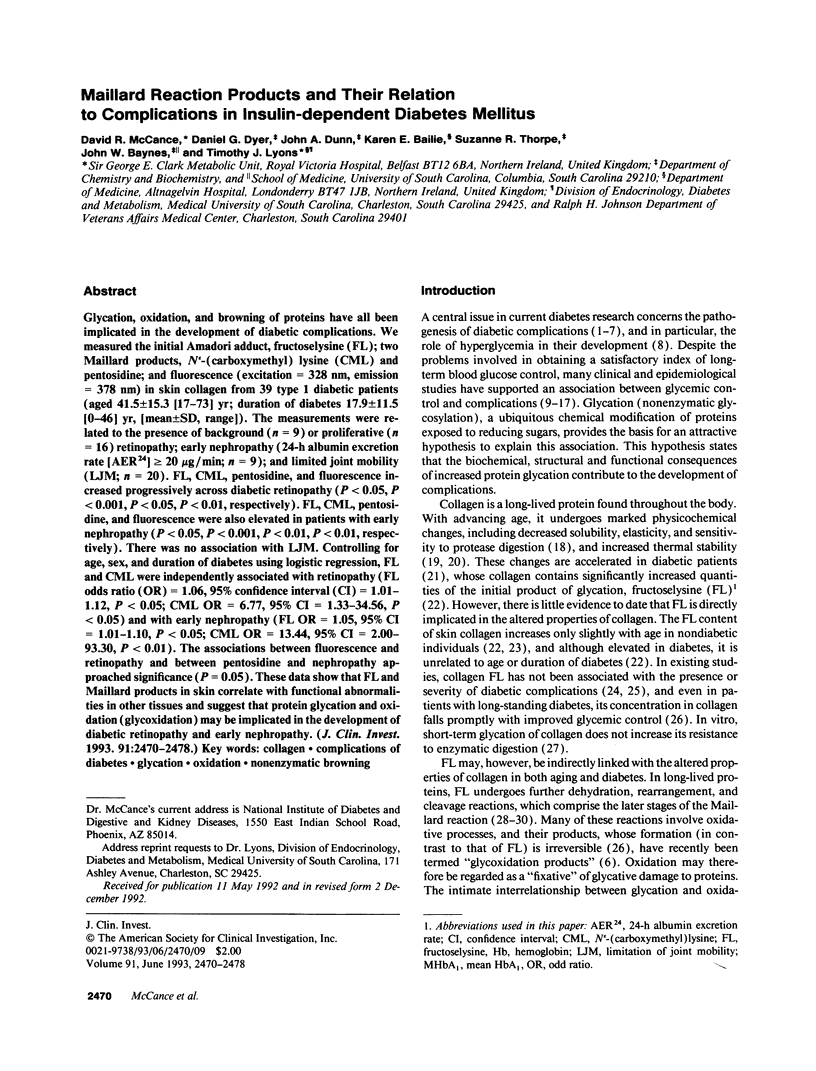
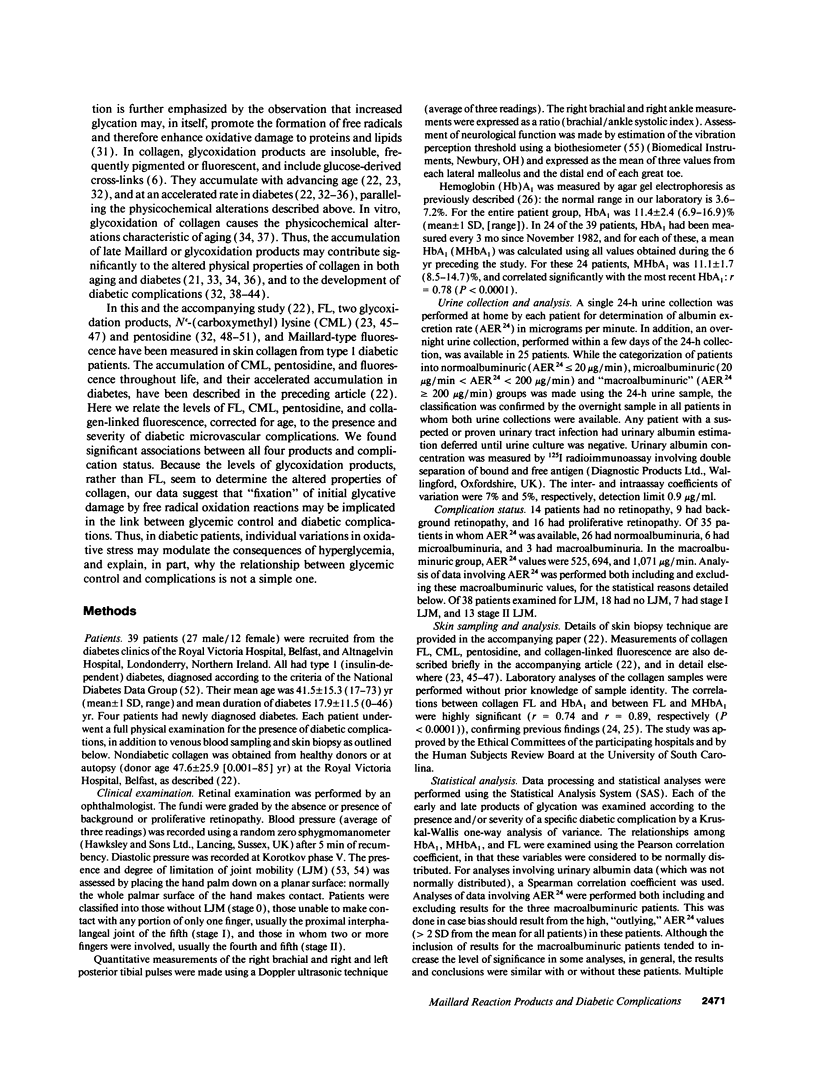
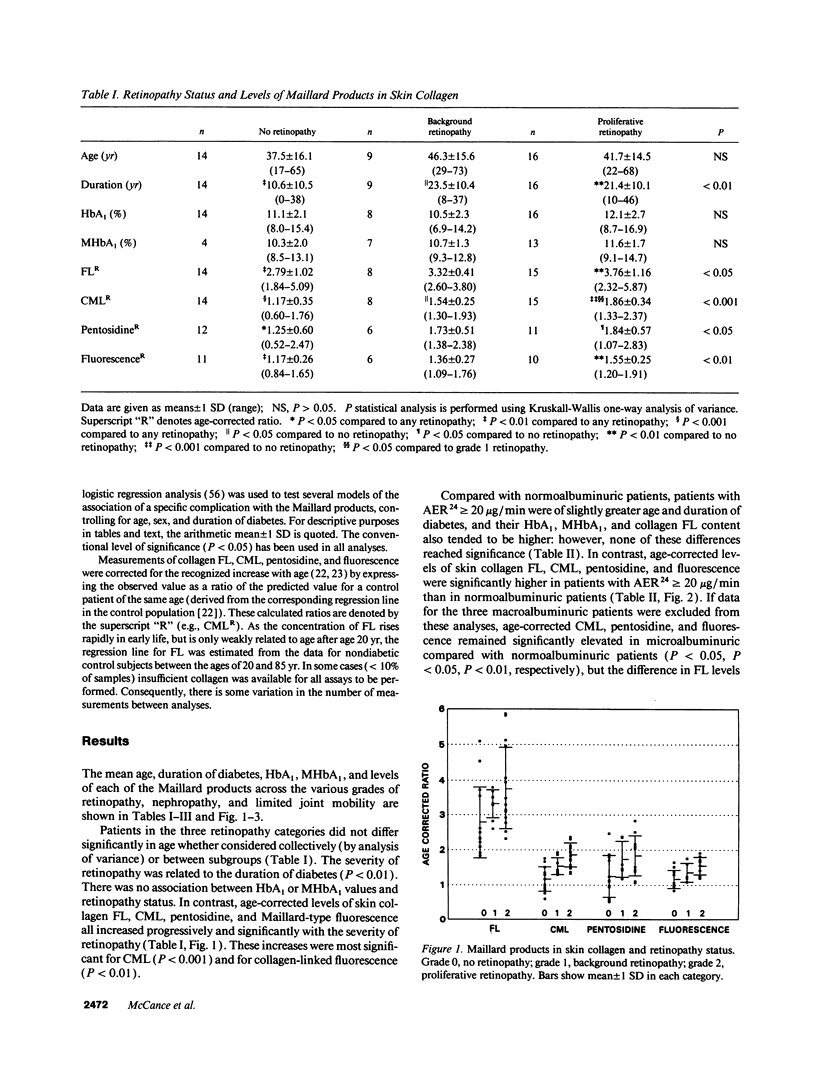
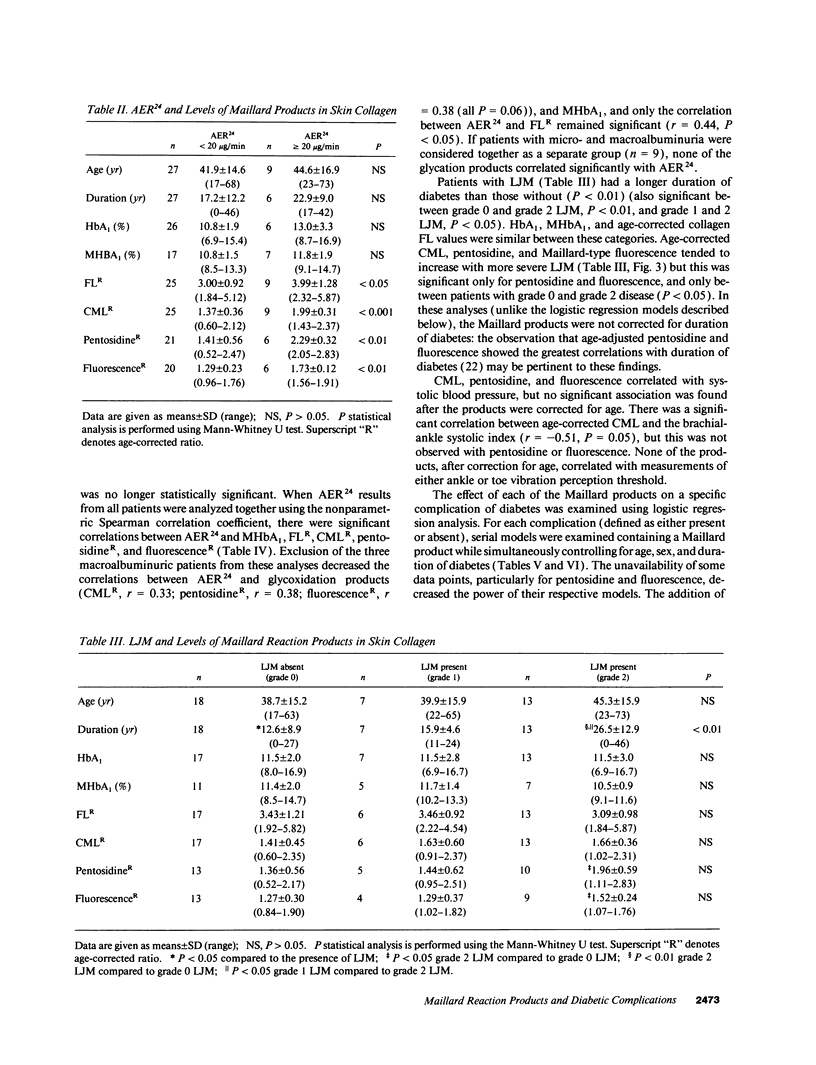
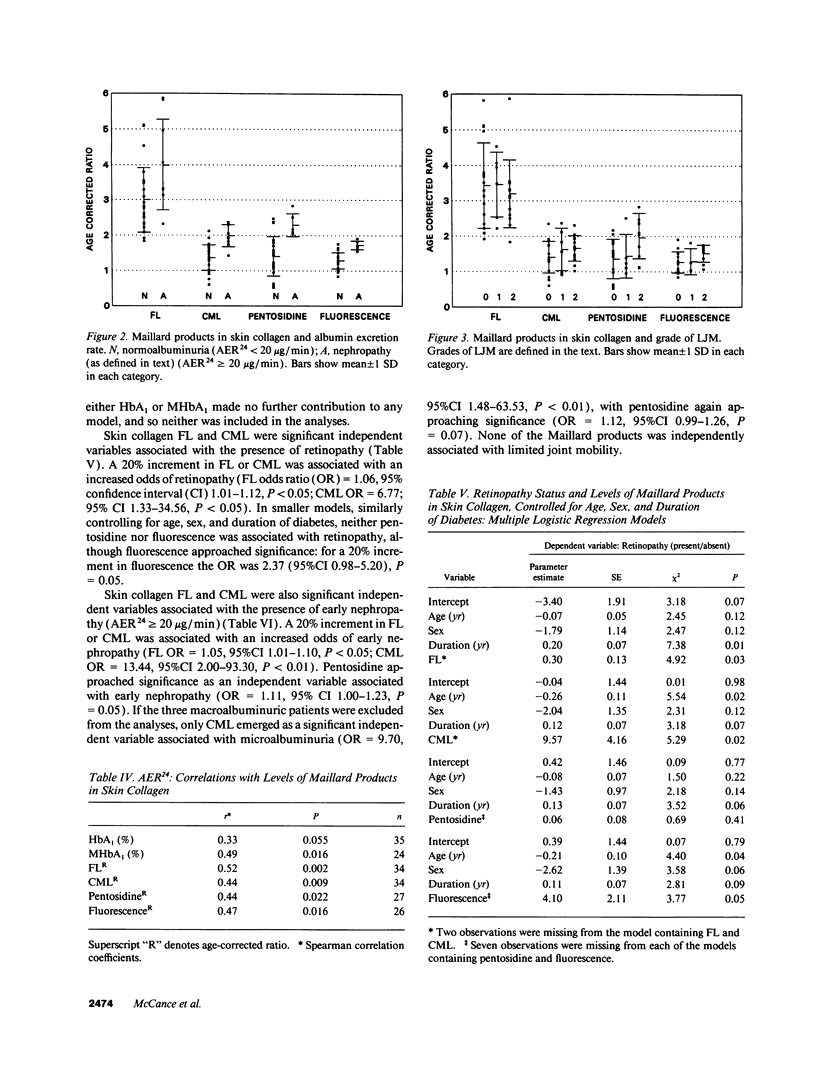
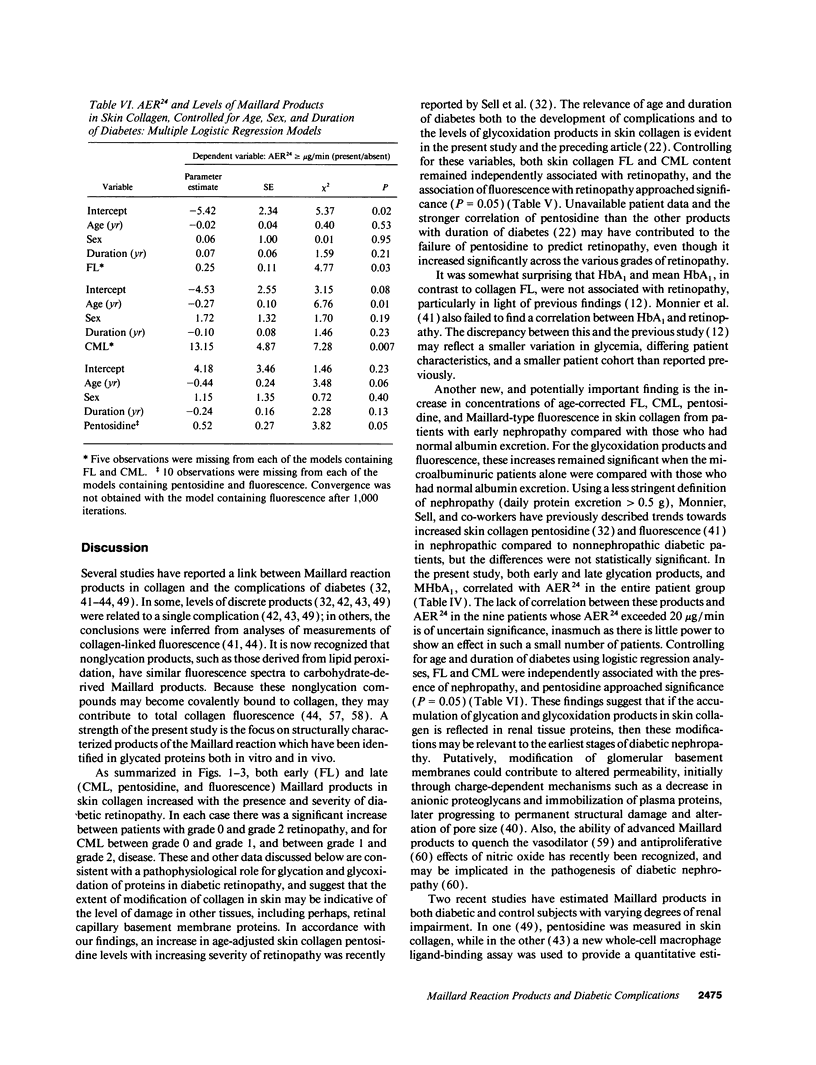
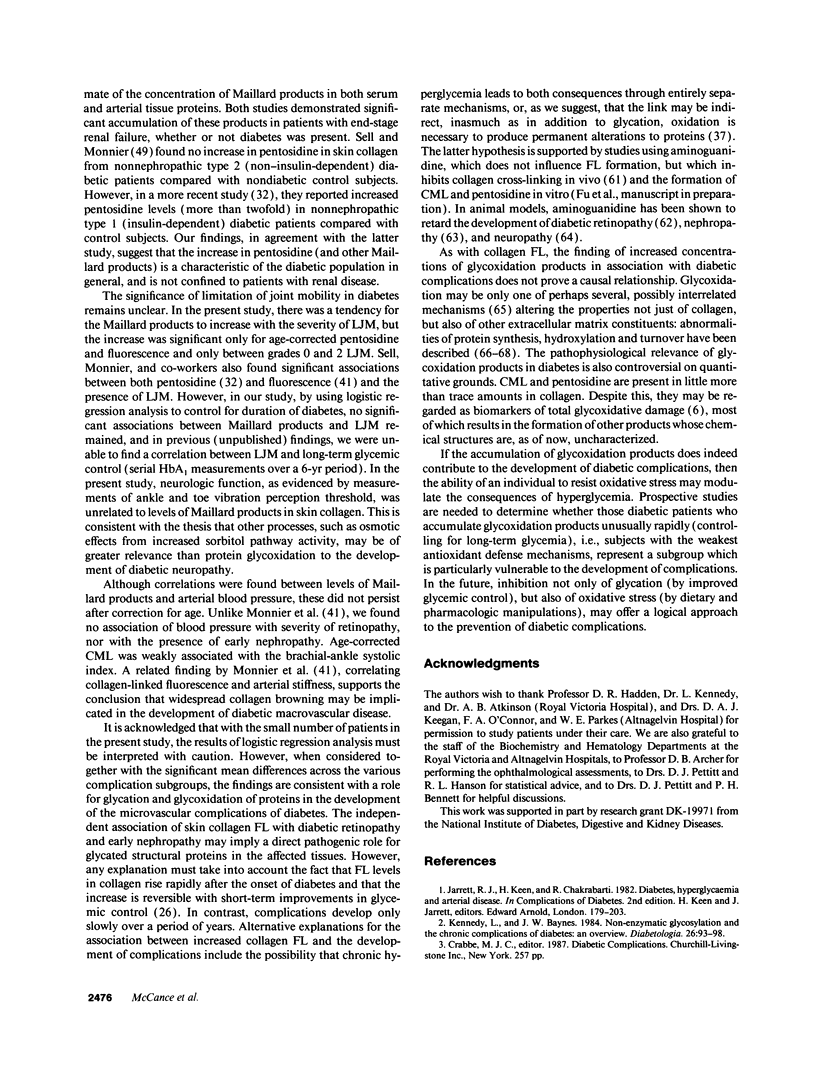

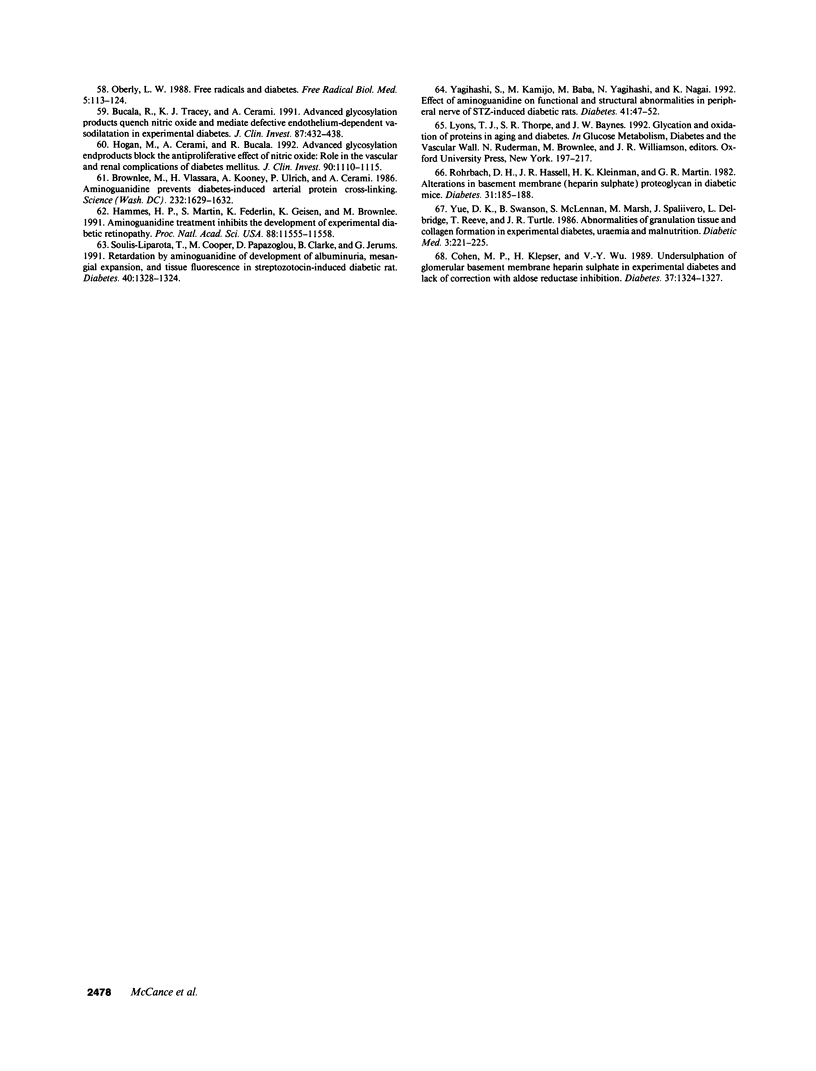
Selected References
These references are in PubMed. This may not be the complete list of references from this article.
- Ahmed M. U., Dunn J. A., Walla M. D., Thorpe S. R., Baynes J. W. Oxidative degradation of glucose adducts to protein. Formation of 3-(N epsilon-lysino)-lactic acid from model compounds and glycated proteins. J Biol Chem. 1988 Jun 25;263(18):8816–8821. [PubMed] [Google Scholar]
- Ahmed M. U., Thorpe S. R., Baynes J. W. Identification of N epsilon-carboxymethyllysine as a degradation product of fructoselysine in glycated protein. J Biol Chem. 1986 Apr 15;261(11):4889–4894. [PubMed] [Google Scholar]
- Baynes J. W. Role of oxidative stress in development of complications in diabetes. Diabetes. 1991 Apr;40(4):405–412. doi: 10.2337/diab.40.4.405. [DOI] [PubMed] [Google Scholar]
- Brinchmann-Hansen O., Dahl-Jørgensen K., Sandvik L., Hanssen K. F. Blood glucose concentrations and progression of diabetic retinopathy: the seven year results of the Oslo study. BMJ. 1992 Jan 4;304(6818):19–22. doi: 10.1136/bmj.304.6818.19. [DOI] [PMC free article] [PubMed] [Google Scholar]
- Brownlee M., Cerami A., Vlassara H. Advanced glycosylation end products in tissue and the biochemical basis of diabetic complications. N Engl J Med. 1988 May 19;318(20):1315–1321. doi: 10.1056/NEJM198805193182007. [DOI] [PubMed] [Google Scholar]
- Brownlee M., Vlassara H., Cerami A. Nonenzymatic glycosylation and the pathogenesis of diabetic complications. Ann Intern Med. 1984 Oct;101(4):527–537. doi: 10.7326/0003-4819-101-4-527. [DOI] [PubMed] [Google Scholar]
- Brownlee M., Vlassara H., Kooney A., Ulrich P., Cerami A. Aminoguanidine prevents diabetes-induced arterial wall protein cross-linking. Science. 1986 Jun 27;232(4758):1629–1632. doi: 10.1126/science.3487117. [DOI] [PubMed] [Google Scholar]
- Bucala R., Tracey K. J., Cerami A. Advanced glycosylation products quench nitric oxide and mediate defective endothelium-dependent vasodilatation in experimental diabetes. J Clin Invest. 1991 Feb;87(2):432–438. doi: 10.1172/JCI115014. [DOI] [PMC free article] [PubMed] [Google Scholar]
- Chase H. P., Jackson W. E., Hoops S. L., Cockerham R. S., Archer P. G., O'Brien D. Glucose control and the renal and retinal complications of insulin-dependent diabetes. JAMA. 1989 Feb 24;261(8):1155–1160. [PubMed] [Google Scholar]
- Cohen M. P., Klepser H., Wu V. Y. Undersulfation of glomerular basement membrane heparan sulfate in experimental diabetes and lack of correction with aldose reductase inhibition. Diabetes. 1988 Oct;37(10):1324–1327. doi: 10.2337/diab.37.10.1324. [DOI] [PubMed] [Google Scholar]
- D'Antonio J. A., Ellis D., Doft B. H., Becker D. J., Drash A. L., Kuller L. H., Orchard T. J. Diabetes complications and glycemic control. The Pittsburgh Prospective Insulin-Dependent Diabetes Cohort Study Status Report after 5 yr of IDDM. Diabetes Care. 1989 Nov-Dec;12(10):694–670. doi: 10.2337/diacare.12.10.694. [DOI] [PubMed] [Google Scholar]
- Dominiczak M. H., Bell J., Cox N. H., McCruden D. C., Jones S. K., Finlay A. Y., Percy-Robb I. W., Frier B. M. Increased collagen-linked fluorescence in skin of young patients with type I diabetes mellitus. Diabetes Care. 1990 May;13(5):468–472. doi: 10.2337/diacare.13.5.468. [DOI] [PubMed] [Google Scholar]
- Dunn J. A., McCance D. R., Thorpe S. R., Lyons T. J., Baynes J. W. Age-dependent accumulation of N epsilon-(carboxymethyl)lysine and N epsilon-(carboxymethyl)hydroxylysine in human skin collagen. Biochemistry. 1991 Feb 5;30(5):1205–1210. doi: 10.1021/bi00219a007. [DOI] [PubMed] [Google Scholar]
- Dunn J. A., Patrick J. S., Thorpe S. R., Baynes J. W. Oxidation of glycated proteins: age-dependent accumulation of N epsilon-(carboxymethyl)lysine in lens proteins. Biochemistry. 1989 Nov 28;28(24):9464–9468. doi: 10.1021/bi00450a033. [DOI] [PubMed] [Google Scholar]
- Dyer D. G., Blackledge J. A., Thorpe S. R., Baynes J. W. Formation of pentosidine during nonenzymatic browning of proteins by glucose. Identification of glucose and other carbohydrates as possible precursors of pentosidine in vivo. J Biol Chem. 1991 Jun 25;266(18):11654–11660. [PubMed] [Google Scholar]
- Dyer D. G., Dunn J. A., Thorpe S. R., Bailie K. E., Lyons T. J., McCance D. R., Baynes J. W. Accumulation of Maillard reaction products in skin collagen in diabetes and aging. J Clin Invest. 1993 Jun;91(6):2463–2469. doi: 10.1172/JCI116481. [DOI] [PMC free article] [PubMed] [Google Scholar]
- Feldt-Rasmussen B., Mathiesen E. R., Deckert T. Effect of two years of strict metabolic control on progression of incipient nephropathy in insulin-dependent diabetes. Lancet. 1986 Dec 6;2(8519):1300–1304. doi: 10.1016/s0140-6736(86)91433-9. [DOI] [PubMed] [Google Scholar]
- Fu M. X., Knecht K. J., Thorpe S. R., Baynes J. W. Role of oxygen in cross-linking and chemical modification of collagen by glucose. Diabetes. 1992 Oct;41 (Suppl 2):42–48. doi: 10.2337/diab.41.2.s42. [DOI] [PubMed] [Google Scholar]
- Fujimori E. Cross-linking and fluorescence changes of collagen by glycation and oxidation. Biochim Biophys Acta. 1989 Oct 5;998(2):105–110. doi: 10.1016/0167-4838(89)90260-4. [DOI] [PubMed] [Google Scholar]
- Greene D. A., Lattimer S. A., Sima A. A. Sorbitol, phosphoinositides, and sodium-potassium-ATPase in the pathogenesis of diabetic complications. N Engl J Med. 1987 Mar 5;316(10):599–606. doi: 10.1056/NEJM198703053161007. [DOI] [PubMed] [Google Scholar]
- Grgic A., Rosenbloom A. L., Weber F. T., Giordano B., Malone J. I., Shuster J. J. Joint contracture--common manifestation of childhood diabetes mellitus. J Pediatr. 1976 Apr;88(4 Pt 1):584–588. doi: 10.1016/s0022-3476(76)80011-x. [DOI] [PubMed] [Google Scholar]
- Hamlin C. R., Kohn R. R., Luschin J. H. Apparent accelerated aging of human collagen in diabetes mellitus. Diabetes. 1975 Oct;24(10):902–904. doi: 10.2337/diab.24.10.902. [DOI] [PubMed] [Google Scholar]
- Hammes H. P., Martin S., Federlin K., Geisen K., Brownlee M. Aminoguanidine treatment inhibits the development of experimental diabetic retinopathy. Proc Natl Acad Sci U S A. 1991 Dec 15;88(24):11555–11558. doi: 10.1073/pnas.88.24.11555. [DOI] [PMC free article] [PubMed] [Google Scholar]
- Hogan M., Cerami A., Bucala R. Advanced glycosylation endproducts block the antiproliferative effect of nitric oxide. Role in the vascular and renal complications of diabetes mellitus. J Clin Invest. 1992 Sep;90(3):1110–1115. doi: 10.1172/JCI115928. [DOI] [PMC free article] [PubMed] [Google Scholar]
- Kennedy L., Baynes J. W. Non-enzymatic glycosylation and the chronic complications of diabetes: an overview. Diabetologia. 1984 Feb;26(2):93–98. doi: 10.1007/BF00281113. [DOI] [PubMed] [Google Scholar]
- Klein R., Klein B. E., Moss S. E., Davis M. D., DeMets D. L. Glycosylated hemoglobin predicts the incidence and progression of diabetic retinopathy. JAMA. 1988 Nov 18;260(19):2864–2871. [PubMed] [Google Scholar]
- Kohn R. R., Cerami A., Monnier V. M. Collagen aging in vitro by nonenzymatic glycosylation and browning. Diabetes. 1984 Jan;33(1):57–59. doi: 10.2337/diab.33.1.57. [DOI] [PubMed] [Google Scholar]
- Lyons T. J., Bailie K. E., Dyer D. G., Dunn J. A., Baynes J. W. Decrease in skin collagen glycation with improved glycemic control in patients with insulin-dependent diabetes mellitus. J Clin Invest. 1991 Jun;87(6):1910–1915. doi: 10.1172/JCI115216. [DOI] [PMC free article] [PubMed] [Google Scholar]
- Lyons T. J., Kennedy L. Effect of in vitro non-enzymatic glycosylation of human skin collagen on susceptibility to collagenase digestion. Eur J Clin Invest. 1985 Jun;15(3):128–131. doi: 10.1111/j.1365-2362.1985.tb00155.x. [DOI] [PubMed] [Google Scholar]
- Lyons T. J., Kennedy L. Non-enzymatic glycosylation of skin collagen in patients with type 1 (insulin-dependent) diabetes mellitus and limited joint mobility. Diabetologia. 1985 Jan;28(1):2–5. doi: 10.1007/BF00276991. [DOI] [PubMed] [Google Scholar]
- Lyons T. J. Oxidized low density lipoproteins: a role in the pathogenesis of atherosclerosis in diabetes? Diabet Med. 1991 Jun;8(5):411–419. doi: 10.1111/j.1464-5491.1991.tb01624.x. [DOI] [PubMed] [Google Scholar]
- MIRSKY I. A., FUTTERMAN P., BROHKAHN R. H. The quantitative measurement of vibratory perception in subjects with and without diabetes mellitus. J Lab Clin Med. 1953 Feb;41(2):221–235. [PubMed] [Google Scholar]
- Makita Z., Radoff S., Rayfield E. J., Yang Z., Skolnik E., Delaney V., Friedman E. A., Cerami A., Vlassara H. Advanced glycosylation end products in patients with diabetic nephropathy. N Engl J Med. 1991 Sep 19;325(12):836–842. doi: 10.1056/NEJM199109193251202. [DOI] [PubMed] [Google Scholar]
- McCance D. R., Hadden D. R., Atkinson A. B., Archer D. B., Kennedy L. Long-term glycaemic control and diabetic retinopathy. Lancet. 1989 Oct 7;2(8667):824–828. doi: 10.1016/s0140-6736(89)92996-6. [DOI] [PubMed] [Google Scholar]
- McCance D. R., Hadden D. R., Atkinson A. B., Johnston H., Kennedy L. The relationship between long-term glycaemic control and diabetic nephropathy. Q J Med. 1992 Jan;82(297):53–61. [PubMed] [Google Scholar]
- Merimee T. J. Diabetic retinopathy. A synthesis of perspectives. N Engl J Med. 1990 Apr 5;322(14):978–983. doi: 10.1056/NEJM199004053221406. [DOI] [PubMed] [Google Scholar]
- Monnier V. M., Kohn R. R., Cerami A. Accelerated age-related browning of human collagen in diabetes mellitus. Proc Natl Acad Sci U S A. 1984 Jan;81(2):583–587. doi: 10.1073/pnas.81.2.583. [DOI] [PMC free article] [PubMed] [Google Scholar]
- Monnier V. M., Sell D. R., Abdul-Karim F. W., Emancipator S. N. Collagen browning and cross-linking are increased in chronic experimental hyperglycemia. Relevance to diabetes and aging. Diabetes. 1988 Jul;37(7):867–872. doi: 10.2337/diab.37.7.867. [DOI] [PubMed] [Google Scholar]
- Monnier V. M., Vishwanath V., Frank K. E., Elmets C. A., Dauchot P., Kohn R. R. Relation between complications of type I diabetes mellitus and collagen-linked fluorescence. N Engl J Med. 1986 Feb 13;314(7):403–408. doi: 10.1056/NEJM198602133140702. [DOI] [PubMed] [Google Scholar]
- Oberley L. W. Free radicals and diabetes. Free Radic Biol Med. 1988;5(2):113–124. doi: 10.1016/0891-5849(88)90036-6. [DOI] [PubMed] [Google Scholar]
- Oimomi M., Maeda Y., Baba S., Iga T., Yamamoto M. Relationship between levels of advanced-stage products of the Maillard reaction and the development of diabetic retinopathy. Exp Eye Res. 1989 Aug;49(2):317–320. doi: 10.1016/0014-4835(89)90103-6. [DOI] [PubMed] [Google Scholar]
- Rohrbach D. H., Hassell J. R., Kleinman H. K., Martin G. R. Alterations in the basement membrane (heparan sulfate) proteoglycan in diabetic mice. Diabetes. 1982 Feb;31(2):185–188. doi: 10.2337/diab.31.2.185. [DOI] [PubMed] [Google Scholar]
- Rosenbloom A. L., Silverstein J. H., Lezotte D. C., Richardson K., McCallum M. Limited joint mobility in childhood diabetes mellitus indicates increased risk for microvascular disease. N Engl J Med. 1981 Jul 23;305(4):191–194. doi: 10.1056/NEJM198107233050403. [DOI] [PubMed] [Google Scholar]
- Schnider S. L., Kohn R. R. Effects of age and diabetes mellitus on the solubility and nonenzymatic glucosylation of human skin collagen. J Clin Invest. 1981 Jun;67(6):1630–1635. doi: 10.1172/JCI110198. [DOI] [PMC free article] [PubMed] [Google Scholar]
- Sell D. R., Lapolla A., Odetti P., Fogarty J., Monnier V. M. Pentosidine formation in skin correlates with severity of complications in individuals with long-standing IDDM. Diabetes. 1992 Oct;41(10):1286–1292. doi: 10.2337/diab.41.10.1286. [DOI] [PubMed] [Google Scholar]
- Sell D. R., Monnier V. M. End-stage renal disease and diabetes catalyze the formation of a pentose-derived crosslink from aging human collagen. J Clin Invest. 1990 Feb;85(2):380–384. doi: 10.1172/JCI114449. [DOI] [PMC free article] [PubMed] [Google Scholar]
- Sell D. R., Monnier V. M. Structure elucidation of a senescence cross-link from human extracellular matrix. Implication of pentoses in the aging process. J Biol Chem. 1989 Dec 25;264(36):21597–21602. [PubMed] [Google Scholar]
- Soulis-Liparota T., Cooper M., Papazoglou D., Clarke B., Jerums G. Retardation by aminoguanidine of development of albuminuria, mesangial expansion, and tissue fluorescence in streptozocin-induced diabetic rat. Diabetes. 1991 Oct;40(10):1328–1334. doi: 10.2337/diab.40.10.1328. [DOI] [PubMed] [Google Scholar]
- Strowig S., Raskin P. Glycemic control and diabetic complications. Diabetes Care. 1992 Sep;15(9):1126–1140. doi: 10.2337/diacare.15.9.1126. [DOI] [PubMed] [Google Scholar]
- Vishwanath V., Frank K. E., Elmets C. A., Dauchot P. J., Monnier V. M. Glycation of skin collagen in type I diabetes mellitus. Correlation with long-term complications. Diabetes. 1986 Aug;35(8):916–921. doi: 10.2337/diab.35.8.916. [DOI] [PubMed] [Google Scholar]
- Yagihashi S., Kamijo M., Baba M., Yagihashi N., Nagai K. Effect of aminoguanidine on functional and structural abnormalities in peripheral nerve of STZ-induced diabetic rats. Diabetes. 1992 Jan;41(1):47–52. doi: 10.2337/diab.41.1.47. [DOI] [PubMed] [Google Scholar]
- Yue D. K., McLennan S., Delbridge L., Handelsman D. J., Reeve T., Turtle J. R. The thermal stability of collagen in diabetic rats: correlation with severity of diabetes and non-enzymatic glycosylation. Diabetologia. 1983 Apr;24(4):282–285. doi: 10.1007/BF00282714. [DOI] [PubMed] [Google Scholar]
- Yue D. K., Swanson B., McLennan S., Marsh M., Spaliviero J., Delbridge L., Reeve T., Turtle J. R. Abnormalities of granulation tissue and collagen formation in experimental diabetes, uraemia and malnutrition. Diabet Med. 1986 May;3(3):221–225. doi: 10.1111/j.1464-5491.1986.tb00748.x. [DOI] [PubMed] [Google Scholar]


